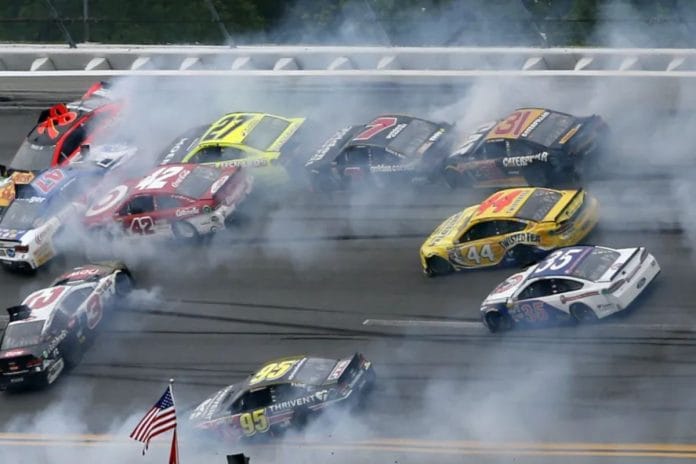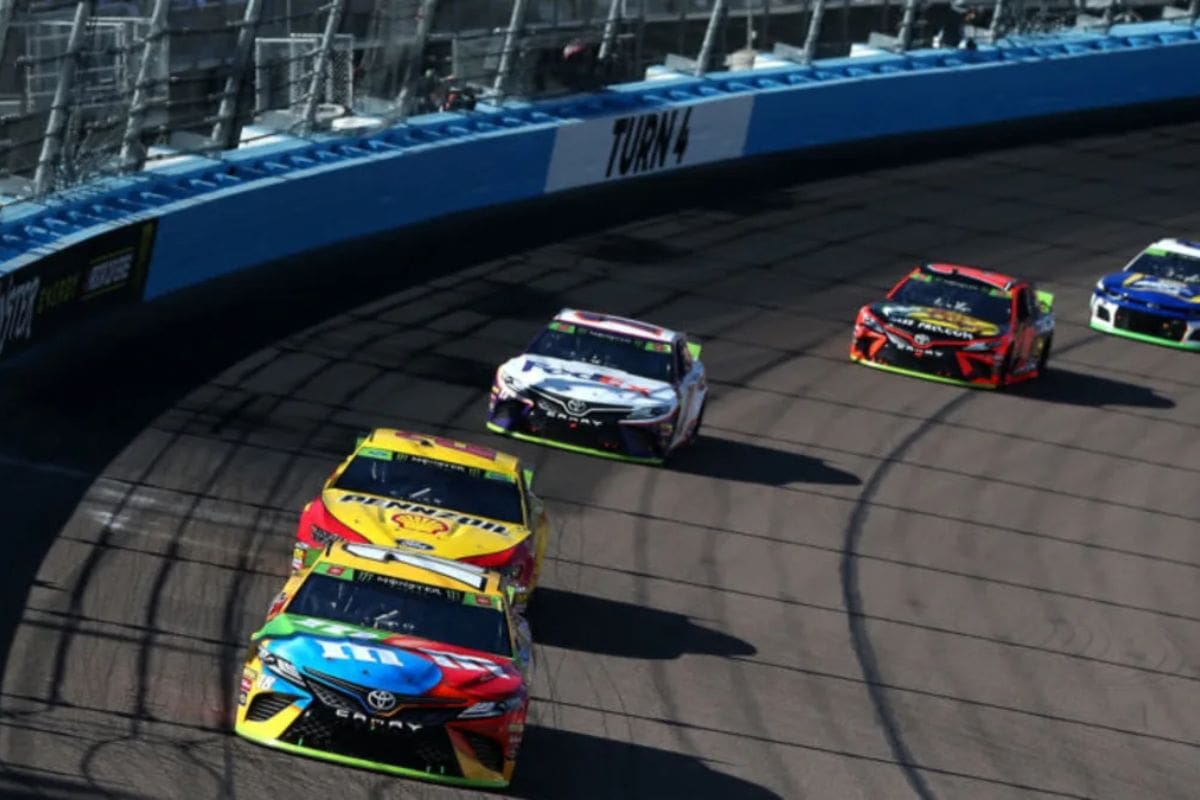The Talladega Crash That Altered NASCAR Forever: The 1993 DieHard 500 at Talladega Superspeedway stands as a turning point in NASCAR, illustrating the balance between speed and safety. The harrowing crash that claimed Stanley Smith’s life-altering skull fracture and left Jimmy Horton with devastating injuries forced the racing community to confront its vulnerabilities. This incident sparked an urgent dialogue on driver safety and set in motion a series of reforms that would reshape the sport. As we examine the aftermath and its profound impact, it becomes clear that this tragedy was not merely an event, but a catalyst for change in NASCAR’s evolving narrative.
Key Highlights
- The 1993 DieHard 500 at Talladega featured a catastrophic wreck involving drivers Jimmy Horton and Stanley Smith, leading to significant safety concerns in NASCAR.
- Stanley Smith suffered a basilar skull fracture, resulting in a 40-day coma and paralysis on the left side of his face.
- The incident prompted immediate safety improvements, including roof flaps, catchfences, and HANS devices to protect drivers during crashes.
- Enhanced safety measures were established following the crash, significantly reducing injuries from debris and improving vehicle design for resilience.
The Talladega Superspeedway Legacy
The Talladega Superspeedway stands as a monumental tribute to the highs and lows of NASCAR, embodying a rich legacy of speed, innovation, and peril on its legendary 2.66-mile oval. Since its inception in 1969, the track has evolved into a crucible where engineering marvels and driver skill converge, producing some of the most exhilarating and frightening moments in motorsport history.
The speedway is not merely a venue but a living representation of the relentless pursuit of speed, with Bill Elliott’s historic lap of 212.809 mph in 1987 serving as a benchmark that redefined the parameters of possibility in NASCAR.
However, this pursuit comes at a steep price, with the specter of danger ever-present. The infamy of the ‘Big One,’ a term synonymous with catastrophic multi-car collisions, highlights the inherent risks of racing at such high velocities. The 31-car pileup during the 2002 Aaron’s 312 Busch Series race exemplifies the chaotic nature of this track, where split-second decisions can lead to life-altering consequences.
The legacy of Talladega is one of duality, capturing the thrill of victory alongside the sobering reality of tragedy. It challenges drivers and teams to push the envelope of technology and human endurance, while simultaneously demanding a profound respect for the sport’s darker undertones.
Consequently, Talladega remains a hallowed ground in NASCAR, a place where speed and danger coalesce into a narrative that continues to shape the future of racing.
The 1993 DieHard 500 Incident
Amidst the excitement of the 1993 DieHard 500 at Talladega, a series of events unfolded that not only captivated fans but also highlighted the sport’s precarious intersection of success and tragedy. Just weeks after the passing of beloved driver Davey Allison, the atmosphere was charged with emotion as the race began. While the crowd cheered for the pole winner, Bill Elliott, it was Dale Earnhardt who ultimately prevailed, marking the 6th victory of his storied career.
However, the race was blemished by two notable incidents that shifted the focus from celebration to concern. The crashes were clear reminders of the inherent dangers in NASCAR, leading to a reevaluation of safety protocols within the sport. The consequences of these accidents would resonate deeply, prompting discussions that would forever alter the landscape of racing.
These incidents, juxtaposed with Earnhardt’s victory, encapsulated the duality of NASCAR—a sport defined by speed and thrill, yet haunted by the specter of risk. As NASCAR evolved in the wake of the 1993 DieHard 500, the lessons learned that day would pave the way for a renewed focus on driver safety, forever changing the narrative of the sport.
The Tragic Accidents of Jimmy Horton and Stanley Smith
Within the context of NASCAR‘s ongoing battle with safety, the tragic accidents of Jimmy Horton and Stanley Smith during the 1993 DieHard 500 serve as a striking reminder of the sport’s perilous nature, emphasizing the risks faced by even the lesser-known drivers in high-stakes environments.
At a time when safety measures were inadequate, both drivers found themselves ensnared in a catastrophic wreck that highlighted the unpredictable dangers of stock car racing.
On July 25, 1993, the race commenced with Horton and Smith starting from the 24th and 35th positions, respectively. The race took a dark turn on Lap 69 when Smith’s car was nudged, causing him to lose control and trigger a multi-car pileup.
Horton’s vehicle was particularly vulnerable, flipping violently as it careened off the banking and out of the track’s confines. The absence of catchfences at that portion of Talladega exacerbated the severity of the incident, revealing critical gaps in safety protocols.
Despite the harrowing nature of the crash, Horton emerged with minimal injuries, demonstrating a remarkable resilience. His light-hearted demeanor post-incident, where he jested with reporters, reflected both his luck and an indomitable spirit.
“I knew I was in trouble when the first guy who got to the window after the crash was holding a beer.” – Horton
Conversely, Smith bore the brunt of the impact, suffering injuries that would forever alter his career path. These accidents marked essential moments in NASCAR history, driving the urgency for improved safety measures that would eventually reshape the sport.
Stanley Smith’s Severe Injuries and Recovery
Following the catastrophic crash at Talladega, Stanley Smith faced a harrowing expedition of recovery marked by both physical and emotional challenges as he grappled with the aftermath of his severe injuries. The basilar skull fracture he sustained was not only life-threatening but also representative of the inherent dangers of NASCAR racing. This specific fracture type, notorious for its brutality, left him in a coma for 40 days, highlighting the precarious nature of motorsports.
Despite the grim prognosis, Smith’s survival remained a reflection of both medical intervention and sheer willpower. His quest through multiple surgeries revealed the relentless battle between resilience and vulnerability. The paralysis on the left side of his face served as a permanent reminder of that fateful day, yet it could not extinguish his passion for racing. Upon regaining consciousness, he shifted his focus to regional racing circuits, where he found a semblance of joy and fulfillment, culminating in a victory at the NASCAR Southeast Series.
However, the shadow of his injuries lingered throughout his life, shaping not just his racing career but also his identity. Stanley Smith’s story, while not as widely celebrated as some of his contemporaries, embodies the grit and resolve that define the spirit of stock car racing.
Safety Improvements and Legacy
In the wake of tragic incidents that highlighted the inherent dangers of NASCAR racing, notable safety improvements have been implemented, transforming not only the cars themselves but also the extensive environment of the sport to better protect both drivers and fans.
The introduction of mandatory roof flaps in 1994 marked a major advancement, effectively reducing the frequency of airborne incidents and improving vehicle stability during high-speed actions. This innovation has become a hallmark of modern NASCAR design, reflecting a commitment to evolving safety standards.
Moreover, the establishment of catchfences at tracks like Talladega has revolutionized spectator safety. Following the harrowing events involving Neil Bonnett and Jimmy Horton, NASCAR took proactive measures to create a secure viewing environment. The installation of reinforced catchfences along the raceway has considerably mitigated the risk of debris injuries, as evidenced by incidents like Ricky Craven’s 1996 crash, where the catchfence played a vital protective role.
The legacy of these safety improvements is profound, as they resonate not only through technological advances like the HANS device but also through a cultural shift within the sport that prioritizes driver and fan welfare.
Despite the inherent risks of motorsports, NASCAR’s dedication to continuous improvement emphasizes a broader commitment to safety. As the sport looks toward the future, it remains essential to assess and implement further advancements to safeguard every participant. The legacy of those early crashes continues to inspire a relentless pursuit of excellence in safety measures within NASCAR.
News in Brief: The Talladega Crash That Altered NASCAR Forever
The 1993 DieHard 500 at Talladega Superspeedway serves as a crucial turning point in NASCAR’s approach to driver safety.
The harrowing experiences of Stanley Smith and Jimmy Horton highlighted the inherent dangers of high-speed racing, prompting the implementation of essential safety measures such as catchfences and HANS devices.
These reforms not only improved driver protection but also reshaped the regulatory framework of the sport, ensuring that the legacy of that tragic day continues to influence NASCAR safety protocols to this day.
ALSO READ: Talladega Superspeedway New Logo: A Bold Tribute to Racing Legacy





